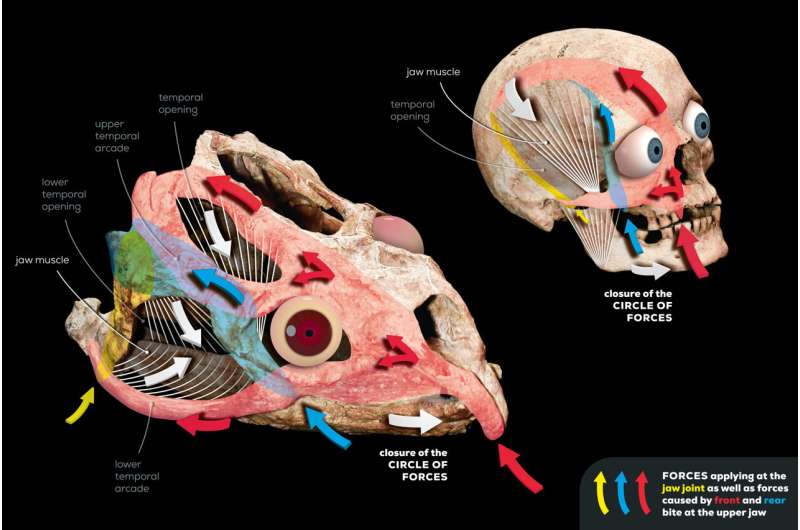This article has been reviewed according to Science X's editorial process and policies. Editors have highlighted the following attributes while ensuring the content's credibility:
fact-checked
trusted source
proofread
Temple bones in the skulls of dinosaurs and humans alike were formed by feeding habits, study suggests

Whether human or reptile, in the skull of most terrestrial vertebrates there is a gaping hole in the temple; in the case of most reptiles, there are two. Scientists have been looking for explanations for this for 150 years.
A team of researchers from the University of Tübingen and Ruhr University Bochum has now shown that the forces acting on the skull change depending on how and where food is held, bitten and chewed in the mouth—and over millions of years, these factors lead to the formation of connections and openings in the skull. Knowing this makes it easier for researchers to reconstruct extinct animals' way of life. The research is published in The Anatomical Record journal.
"The diversity of skull and bone shapes has been described in detail by paleontologists and zoologists—but the origin of the bars and openings at the temple and what they tell us about the biology and relationship of terrestrial vertebrates has not yet been convincingly explained," says PD Dr. Ingmar Werneburg from the Senckenberg Center for Human Evolution and Paleoenvironment at the University of Tübingen and curator of the University's Paleontological Collection.
"Our model is based on the idea that bone mass can only be formed in places where there are compressive stresses," says Professor Holger Preuschoft, emeritus of functional morphology at the Institute of Anatomy at Ruhr University Bochum and co-author of the study. "There must also be mechanical rest at the sites of bone formation. This means that there must be no movement that could lead to the formation of a false joint, a pseudarthrosis."
Humans too have a large temporal opening above the zygomatic arch, or cheekbone. The jaw muscle runs down through it to the lower jaw. When chewing, the movement of this muscle can be felt with the hand at the wide temporal opening.
In various fossil reptiles, including dinosaurs, the openings are shaped very differently. The two scientists compared dozens of land vertebrate skulls from several million years of evolutionary history.
The researchers say that when animals bite hard at the front of the jaw—for example with the help of fangs—great tension spreads above and below the eyes and towards the neck, leading to the formation of bone braces in the temple. In reptiles, there is a further effect: they bite primarily at the back of the jaw, where shorter leverage from the jaw joint enables greater biting force.
"This also creates a compressive stress that requires a bone bridge behind the eye," says Werneburg, "If this comes into contact with the upper compressive stress of the front bite, both forces are partially redirected and a second zygomatic arch can form."
In earlier studies, Holger Preuschoft demonstrated the effect of these forces on the skulls of animal species alive today; he also tested the load at which the bones break. The current study applies these findings for the first time to the evolutionary history of vertebrates.
When the animal shakes its prey or tears leaves off a plant, additional lateral shearing forces are generated, which lead to further modifications of the temple. With the help of the jaw muscles, the acting forces are transferred to the starting point of the force in the teeth in a circuit of force. "Otherwise, the skull would not be stable and would crack," says Preuschoft.
More information: Ingmar Werneburg et al, Evolution of the temporal skull openings in land vertebrates: A hypothetical framework on the basis of biomechanics, The Anatomical Record (2024). DOI: 10.1002/ar.25371
Provided by Universitaet Tübingen




















